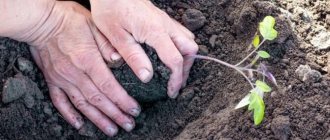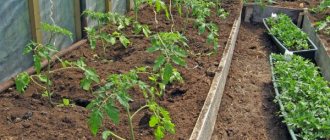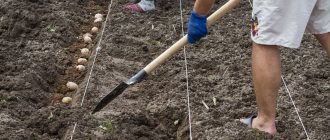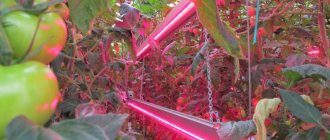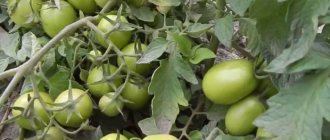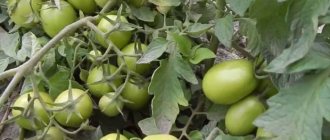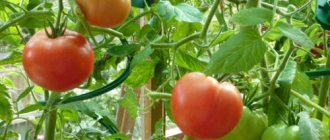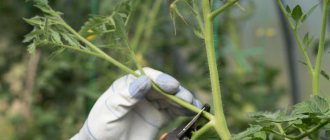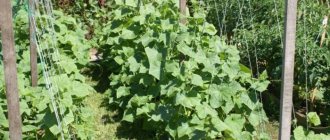Planting tomatoes in a greenhouse has its advantages. Even in an unheated room, the crop ripens two weeks earlier than in open ground. And the yield of greenhouse tomatoes is 2-3 times higher.
Therefore, in order to reap a good harvest of tomatoes grown indoors, you must follow a number of simple rules when planting. Namely, maintain a minimum distance when planting various types of tomatoes in a greenhouse. To save useful space, use diagrams.
What is the danger of thickening plantings in closed ground?
Many gardeners, in order to save usable space and increase productivity by increasing the number of bushes, plant tomatoes in greenhouses thicker than recommended. However, this should not be done, since thickening the plantings can lead to the opposite effect - a lower and later harvest.
To reap a good harvest, you must adhere to some rules when planting. Thickening of the planting is extremely undesirable. This is due to the fact that:
- Tomatoes love brightly lit growing areas. With dense planting, shading of neighboring bushes occurs, which negatively affects the growth and ripening of fruits and the development of the plant itself.
- Each seedling has its own rate of growth and development, and, therefore, one plant’s root system can develop faster than its neighbor’s. If the distances between them are too close, moisture and nutrients are distributed unevenly, which leads to a delay in the growth of one of them.
- When planted densely, difficulties arise with care and harvesting.
- Thickening creates a lack of moisture and nutrition for the tomatoes.
- Plants located close to neighboring ones come into contact with leaves and other parts. This creates a favorable environment for the spread of many diseases and the proliferation of pests.
How to calculate tomato planting density
For planting, use 2 - 3 beds - this is the best scheme for planting tomatoes in a greenhouse measuring 3x6 meters.
Tomato planting scheme
At what distance to plant onions?
Two beds are placed along the side walls of the polycarbonate greenhouse, their width does not exceed 1 m. You can use parallel planting of seedlings, but it is better to place the bushes in a checkerboard pattern. This will allow you to plant approximately 60 bushes. Tomatoes are planted in a greenhouse so that the distance between the bushes corresponds to the standards for a particular variety.
If you organize 3 beds according to the scheme: the outer ones along the walls are 60 cm wide, and the middle one is 1 m, the width of each path between the beds will be 40 cm.
It is recommended to plant low-growing early varieties on the outer beds, and mid-ripening tall tomatoes on the middle beds. This placement will provide sufficient lighting to all bushes.
Note! Varieties with different ripening periods can be planted on each row. This planting will allow you to place up to 90 bushes.
It will be possible to place 40 more bushes in a 3x8 m greenhouse.
We calculate the required number of bushes per greenhouse area
When planting tomatoes in closed ground, it is necessary to make maximum use of the usable area, taking into account the needs of each variety. And also plant the tomatoes so that you have free access to each bush.
The recommended interval between bushes is at least 35 cm for early varieties and at least 45 cm for middle and late varieties. The distance between rows is 70-80 cm. On average, 1 tomato bush accounts for 0.3 meters of square usable area.
The beds in the greenhouse are placed in the direction from west to east. For a small greenhouse (for example, 3x6 m), two beds are laid out and 1 pass is made, or 3 beds are made with 2 passes. In a small area it is advisable to make longitudinal beds.
Optimal distance between tomatoes
The norm for planting seedlings per 1 m2 of soil depends on the type of bush and variety:
- Indeterminate varieties that will be formed into one stem - 3 bushes, into two stems - 2.5 bushes.
- Determinate - in two or more stems - 2.5-3 bushes, in one stem - 3-4 bushes.
- Superdeterminate varieties - 4–6 bushes.
When calculating the distance between plants, you need to know the width of the greenhouse or plot. It is better to mark the planting scheme on paper, then it will be easier to make corrections. Plan indentations from the edge of the plot or the wall of the greenhouse, distances between rows, passages between ridges.
Determining the distance between seedlings of different varieties
Each tomato variety has its own special characteristics, as well as space requirements that you need to know when planting. Depending on the height of the bush, the distance between the seedlings is determined. There are several types of tomatoes: indeterminate, determinate and low-growing.
Indeterminate
Popular among gardeners due to their high yields. But they are not suitable for planting in small and low greenhouses. The main characteristic of the variety is unlimited stem growth. The bush reaches 250-300 cm in height and has 2-3 stems.
Large plant sizes require space and proper care. For this species, it is recommended to leave an interval of 80-90 cm between rows and at least 65 cm between bushes in a row. No more than 2 seedlings are planted per 1 square meter.
Indeterminate varieties include “tomato tree” or “liana”. This variety has unlimited height growth and several strong trunks. Suitable for large greenhouses only. When planting, an ordinary scheme is used. The optimal distance between neighboring bushes is at least 1 meter.
Determinate (medium-sized)
The main characteristic is a stop in the growth of the bush after the formation of the ovary. Determinate tomatoes reach a height of 120-150 cm.
The distance between rows for taller ones is 70-80 cm, for lower ones - from 50 cm. Approximately 40 cm is left between bushes in a row. Up to 4 seedlings can be placed on 1 square meter.
Low-growing, standard
They grow no more than 45 cm. They are characterized by a strong and wide trunk and a small root system. Compared to other varieties, they have lower yields, but are valued for their unpretentiousness and ease of care.
Planting low-growing tomatoes
Low-growing tomatoes produce an early harvest, so they are highly valued by gardeners. When planting tomatoes of these varieties, you can leave up to 30 cm of free space between the bushes, and 50 cm between the rows. Below is the planting distance for low-growing varieties of tomatoes.
A checkerboard planting will be successful, in which up to 10 bushes can fit per 1 sq.m.
- Is it worth growing low-growing tomatoes - 8 arguments in favor
Do you doubt that low-growing tomato varieties can become worthy rivals to giants? We will present arguments that will convince you.
The best planting schemes for tomatoes in a greenhouse
The planting scheme allows you to rationally plant tomatoes in a limited area of the greenhouse while maintaining distances. Different patterns are used for different varieties of tomatoes. When choosing a design, it is important to consider the plant's vigor and characteristics.
Square-nested
This method of landing was widespread back in the Soviet Union. Suitable when using mechanized processing and harvesting methods. The intervals between the rows and bushes in the row are the same and amount to 70 cm.
Seedlings are located in the corners of the square. In order to increase the number of bushes per usable area, not one, but two or three plants are planted at a close distance from each other (nest). Subsequently, the planting is thinned out and non-viable plants are pulled out.
Chess
Suitable for tomatoes that form more than one stem, medium-sized determinate varieties. First, one row is formed. After planting the first one, the second one is planted at a distance of 50-60 cm. It is not recommended to plant both rows at the same time. The seedlings of the second row are located between the seedlings of the first, forming a checkerboard pattern.
Depending on the type and number of stems, the spacing between plants is maintained. For indeterminate varieties, the spacing between rows should be 70 cm. The more shoots a tomato has, the wider the bushes are planted.
Parallel landing
Applicable for all types. It differs from the ordinary one in that the tomatoes are planted in two rows. Each two-row is separated by a passage of 90-100 cm. The distance between the rows is from 40 to 50 cm. The planting interval in the row is 50-70 cm, depending on the type. Another name is “ribbon-cluster” planting. This method is good for planting low-growing species.
The disadvantage of this method is partial shading of the plants.
Also, planting in a parallel pattern takes up a lot of space and is not suitable for small greenhouses. The advantages include convenient access to the plant for care and harvesting, both manually and mechanized.
What is the importance of maintaining the distance at which you need to plant tomatoes?
Planted fragile tomato seedlings quickly begin active growth and soon turn into adult plants with a large amount of green mass. This must be taken into account when choosing a seedling planting scheme and determining the distance between bushes. In order for the plant to develop well and bear fruit, when planting it must be provided with:
- sufficient supply area;
- normal lighting;
- ventilation.
An equally important point is the creation of conditions for care (watering, tying, shaping, hilling).
Advice from experienced gardeners
- Before you start planting, you need to plan the planting of seedlings. To do this, you will need a measuring tape, ropes and a marker (a piece of wood for marking the future hole).
- Do not make the intervals between seedlings too large. This stimulates the growth of leaves and unnecessary branches.
- The diameter of the hole is up to 20 cm for short types of tomatoes and 30-35 cm for medium-sized and tall ones. Depth 15-20 cm.
- You should not plant tomatoes where peppers or eggplants used to grow. But cabbage and cucumbers will be good predecessors.
- It is not advisable to plant tomatoes and cucumbers together due to different temperature conditions and the greater need for hydration of cucumbers.
- You can place 2-3 seedlings in one hole, but the intervals between holes will have to be increased based on the needs of each plant for sunlight and nutrition.
- Before planting seedlings, the soil in the greenhouse is fertilized with superphosphate.
- Planting tomatoes in a greenhouse should be done on a cloudy, not hot day or in the afternoon in slightly moistened soil. The optimal height of seedlings for planting is 30-35 cm.
- When planting indeterminate tomato species, slight thickening is allowed. In this case, stepsoning and the presence of hanging supports are mandatory.
To obtain a rich harvest, you should follow the recommended standards when planting. In order to save space in the greenhouse and make optimal use of the usable area, you should carefully plan the location of the beds and passages and determine the pattern of planting seedlings.
Maintaining intervals between bushes will allow you to easily approach the plant and create conditions for growth and development for the plant itself.
When is the best time to plant tomatoes?
Seedling
There are no exact dates, because each region has different climatic conditions. The optimal soil temperature should be at least 12°C, and the air temperature 15°C during the day and not lower than 8°C at night.
In central Russia, it is recommended to start planting on the following dates:
| Greenhouse type | Optimal date |
| Heated | April 20-30 |
| Polycarbonate | May 1-10 |
| Film | May 13-10 |
In the northern regions (Urals, Siberia, Leningrad region):
| Greenhouse type | Optimal date |
| Heated | April 25 - May 5 |
| Polycarbonate | May 7-15 |
| Film | May 18-27 |
Seeds
If you are going to plant tomato seeds in a greenhouse, then you should do this much earlier. Planting is carried out during February-March, and the soil temperature should be 15-17 C, so heating is indispensable.
| Greenhouse type | Optimal date |
| Polycarbonate | February 22 – March 5 |
| Film | March 15-25 |
Tomato care
Growing tomatoes in greenhouses requires compliance with basic regimes. They will vary slightly depending on the time of year.
Table 3: Regimes for growing tomatoes in a greenhouse
| Mode | In heated winter | In spring | Summer-autumn turnover |
| Temperature* | The soil warms up to 18-20 degrees. The air temperature changes according to the development phase of tomatoes: - before flowering 22-24° on a sunny day and 18-20 on a cloudy day; at night 15-16°; - budding - the indicators increase by a couple of degrees; - fruiting - temperature rises another 2° | The same temperatures are maintained throughout the entire period: — on a sunny day 21-23°; — on cloudy days 18-20; — at night 15-16 | The regime changes depending on the month: — July-August: 24-26c (18-20p) during the day; 16-17 at night; — September-October: on a sunny day it is reduced by 4°, on a cloudy day by 1; at night by 2; — November: 18-20s (17-19p) during the day, 14-15 at night The temperature in the soil is maintained at 17-18° throughout the season. |
| Humidity | To ensure better pollination, a relatively dry climate is maintained in the greenhouse. | ||
| Watering** | Moderate, as the soil dries with water 20-25 degrees | Watering is rare but plentiful. The soil should be wetted to the entire depth of the fertile layer. Use warm water, not lower than 15° | In the summer months, they adhere to the spring regime. From September to November they gradually switch to winter |
| Feeding | Carried out in stages: - after rooting; - during the first ovaries; - during fruiting Use a mixture of urea, superphosphate, potassium sulfate | Tomatoes are fed 4-6 times per season, maintaining an interval of 2-3 weeks. The composition of fertilizers depends on the development phase: — at the beginning of the growing season, the ratio of potassium and nitrogen is 3:1 (or 2:1); – after fruit set – 1:1 (or 1:2) | Fertilize less frequently compared to other periods and are not tied to development phases. Use phosphorus-potassium fertilizers |
*The air in the greenhouse should not rise above 30 degrees. Otherwise, neither plant pollination nor fruit setting will occur
**Wiring is carried out in the first half of the day, so that by night you can safely open the greenhouse for ventilation (a great way to reduce air humidity)
On tall bushes, stem formation is carried out. In varieties with continuous growth, development of more than 2 m in height is not allowed (the apical point is pinched).
Symptoms of regime violation
When growing tomatoes indoors, compliance with the regimes determines the quality of the future harvest. The development of crops must be closely monitored in order to correct deviations in time.
Table 4: Signs of deviations in cultivation regimes
| Factor | Description |
| Eating disorder | |
| Nitrogen | The deficiency of the component is manifested by reddish-purple veins on the leaves. Stems become thinner, fibrous and hard Excess of the chemical leads to rapid growth of bushes, but slows down flowering. Leaves turn deep green |
| Phosphorus | When there is a deficiency, the cotyledons of tomatoes begin to actively grow upward. Their undersides take on a purple-red hue. The leaves curl up, the plant itself is delayed in development Excessive application of phosphorus provokes the development of chlorosis |
| Potassium | Deficiency slows down the growth of bushes, making them sluggish. Leaves become brittle. First, their edges curl, then bronze spots appear; tissues turn brown and die Due to the excess, the peduncles are shortened, the color of the flowers deteriorates, the lower leaves turn yellow |
| Magnesium | Deficiency leads to chlorosis. The upper unpaired lobe of leaves turns pale |
| Improper watering | |
| Excess moisture | Leads to root rotting. The color of the leaves fades, they become flabby and droop. Growing brown putrefactive spots appear on the plates. A bush can lose all its foliage overnight |
| Flaw | Tomatoes slow down in growth. The leaves droop, starting to turn yellow at the tips. Then they turn brown, wrinkle and fall off. If the problem occurs at the flowering stage, but the flowers also fall off |
| Humidity is not maintained | |
| Low | The leaves lose their elasticity, and their tips turn brown and wrinkle. The edges turn yellow. Flowers dry out and later fall off |
| High | Putrefactive spots appear on any part of the bush, not similar to those that indicate infection with infectious diseases |
| The temperature regime is down | |
| Heat | Due to prolonged intense heat, the ground part of tomatoes turns yellow, starting from the tops. If no action is taken, the bush turns brown and withers. The tips of the sheets dry out, the plates sometimes curl. The roots also suffer, which ends tragically - the plant dies |
Prolonged violation of the basic regimes in the greenhouse will lead to the development of rot, the appearance of powdery mildew, late blight, anthracnose, fusarium and other equally dangerous problems.
Soil preparation
Regardless of which greenhouse you plan to plant tomatoes in, one of the most important indicators of a good harvest is well-prepared soil. This is one of the significant advantages of the greenhouse method of growing tomatoes compared to planting them in open ground - because here you have the opportunity to independently prepare the most suitable soil composition for the growth of vegetables.
As a rule, a greenhouse is installed on a site and the soil that is located on it is used for it. But if you want to achieve high yields of tomatoes, you will have to carry out work to improve the soil.
The soil for planting tomatoes should be loose, light and have good breathability.
In the process of preparing the soil, you should be guided by the following recommendations:
- In the case of clay or loamy soil, in order to improve its structure in the greenhouse, it is necessary to fertilize it with a bucket of humus, peat and sawdust (a bucket per 1 square meter).
- When the site mainly consists of peaty soils, you should add a bucket of small shavings, humus and turf soil, as well as half a bucket of coarse sand per square meter.
- If chernozem predominates in the greenhouse, a bucket of humus and half a bucket of coarse sand are added per square meter.
In addition to organic fertilizers, it is also necessary to use mineral fertilizers - if you adhere to the specified dosage, they will be very beneficial for the plants and will help you get a good harvest of tomatoes. It will be enough to add 1 teaspoon of ammonium nitrate and 3 teaspoons of superphosphate per square meter of soil. If possible, you can additionally add 1-2 tablespoons of wood ash (it contains many useful microelements that are easily absorbed). After all these manipulations, the beds should be dug well and the soil in them should be loosened.
Agronomist experts do not recommend planting tomatoes in the same soil for several years in a row. This is explained by the fact that pests and diseases can survive in the soil for a long period of time, and they will nullify all your efforts to get a good harvest of tomatoes in a polycarbonate greenhouse.
If possible, the best solution would be to build two greenhouses at once and plant tomatoes and cucumbers in them alternately: one year you plant tomatoes, and the next year you plant cucumbers. If there is only one greenhouse, the tomatoes should be planted in the place where cucumbers grew last season; it is first necessary to remove 10-12 centimeters of the top layer of soil from the bed, this way the seedlings are protected from damage to the rhizomes by rot.
When replacing the top layer of soil, it should be disinfected; for this purpose, a hot solution of copper sulfate is used at the rate of 2 tablets of oxychome per ten liters of water.
Timing for planting tomatoes in a greenhouse
To get a bountiful harvest of tomatoes, it is important not only to select a variety, but also to plant planting material in a timely manner. The optimal temperature in the greenhouse should be between 20–25 °C
And the type of structure is of great importance:
- the heated greenhouse is ready to receive seedlings from the end of April;
- an unheated structure with double film can be used from the beginning of May;
- The unheated and uninsulated structure is ready to receive tomatoes at the end of May.
To more accurately determine the timing, you need to take into account climatic features and the variety of tomatoes. The age and characteristics of the seedlings also matter: the seedling must have a strong trunk, a well-developed root and 8 formed leaves.
The most suitable time for planting seedlings
Regarding when seedlings should be planted in a polycarbonate greenhouse, it should first be noted that this depends on the region of your residence and the climatic conditions there. As a rule, seedlings are planted in an unheated greenhouse in early May.
If there is still a threat of possible frost, you should install special arcs in the greenhouse and stretch special material on top so that the seedlings are covered with it and are not harmed. If this is not possible, you should plant later, when you can be 100% sure that there will be no more frosts.
An important point is that you can plant tomato seedlings in a polycarbonate greenhouse in the last week of February or in the first ten days of March. But in this case, you need to take care of good soil moisture, as well as high-quality fertilizer (you can read more about this in the corresponding subsection of this article). Growing tomatoes in a polycarbonate greenhouse has the obvious advantage over a film greenhouse that in this case there is no need to mulch the soil.
At the time of planting, the seedlings must reach a height of 25 centimeters, and at least 60 days in age, only in this case will they feel normal in the greenhouse. If you rush too much, you risk damaging the plant's root system. But you shouldn’t delay planting tomatoes too long - otherwise the seedlings may overgrow.
Step-by-step instructions for landing
Not overgrown seedlings
Tomato plants that are approximately 1.5 months old are excellent for planting in a polycarbonate greenhouse. They should be strong, with thick stems and 8-12 true dark green leaves and well-developed roots. The height of tomato plants should be approximately 30-35 cm, no more.
The sequence of actions when planting normal, not overgrown, tomato seedlings:
To make the process of removing tomatoes from planting containers easier, the plants are well watered shortly before planting. Wells are prepared for seedlings, which are placed according to the selected pattern depending on the type of tomato (determinate or indeterminate). When planting, fertilizers (mineral or organic) are not applied if they were added during soil preparation. Water each hole well, and then plant one tomato in it strictly vertically. Planting tomatoes must be done carefully so as not to destroy the lump of earth in which the roots are located and not to accidentally break the stem. Each tomato plant is planted in prepared holes and buried 3 cm above the earthen coma. After some time, additional roots will grow on some of the stems located underground, which will only enhance the nutritional capacity of the tomatoes. The planting density of tomato seedlings is maintained as required for the selected variety. After placing all the plants in the holes, the seedlings are sprinkled with soil, which is compacted a little so that the roots of the seedlings are in better contact with the soil. For the first couple of days they are shaded so that they do not suffer from the sun
The material used for shading is then removed.
A week or two after planting tomato seedlings in the greenhouse, the ground around them must be mulched with straw or hay in a small layer of approximately 3-5 cm, so that the moisture is retained in the soil as long as possible and evaporates less. This allows you to reduce the frequency of watering and thus reduce the air humidity inside the polycarbonate greenhouse. This will help avoid the risk of developing late blight, which especially often appears on plants under conditions of high humidity and sudden temperature changes.
Stretched or overgrown seedlings
Stretched or overgrown tomato plants are planted as follows:
- In greenhouse beds, make a groove about 5-7 cm deep along the entire length.
- Distribute the seedlings reclining across the bed to outline their location.
- If the tomatoes were grown in a pot, then the earthen ball is quite voluminous and in order not to squeeze the stem at the base of the seedlings, make an additional depression in the groove so that the earthen ball with roots fits there.
- Watering is carried out with warm water separated from chlorine at the rate of 3-4 liters per 1 plant.
- When the water is absorbed into the additional depression, an earthen ball with roots is placed in it, and the plant is placed lying at an angle of approximately 30°.
- The part of the stem on which the leaves were torn off is covered with soil.
- There is no need to tie up the tomato right away, as you can break the stem; it will gradually tend to the top.
Thus, it is possible to plant even very long tomatoes that have become very outgrown or stretched out.
When planting overgrown tomato seedlings, ensure compliance with the pattern and density of plant placement. After all the tomatoes have taken root, mulch the soil around them.
Distances when sowing tomato seeds for seedlings
The first step towards a rich tomato harvest is sowing seeds for seedlings. Tomatoes have good germination, so before planting the seeds do not need to be germinated or stimulated, however, it is recommended to carry out a disinfection procedure (rinse with a 1% manganese solution) and enrichment with mineral fertilizers (you can prepare mixtures for this yourself or buy ready-made ones in specialized stores).
Prepared shallow (no more than 8 cm), sterile containers should be drained (otherwise the tomato roots may begin to rot), then filled with moist soil, not reaching 2 cm from the top edge. Compact it, add soil to the previous level and compact it again. Make several deep rows at a distance of 4-5 cm from each other. Place the seeds in them every 2 cm, cover with dry soil on top, and lightly compact them with your hand. Cover with glass or cellophane and place the seedlings in a warm place.
More dense planting of seeds can lead to the fact that the seedlings will turn out frail and weak - the tomatoes will not have enough moisture and nutrients, they will put pressure on each other’s root systems.
